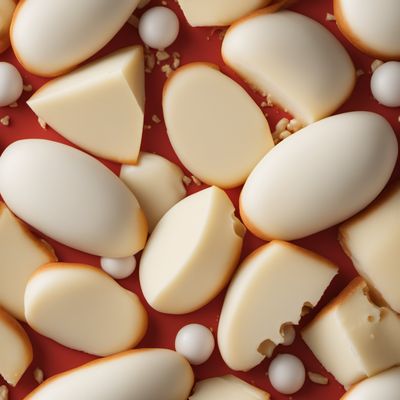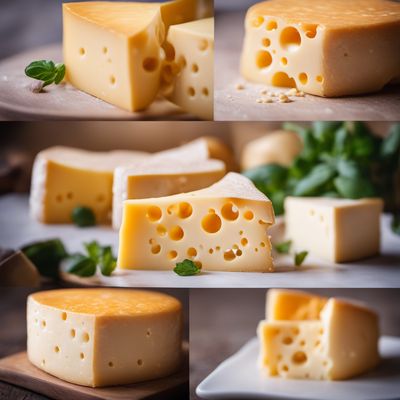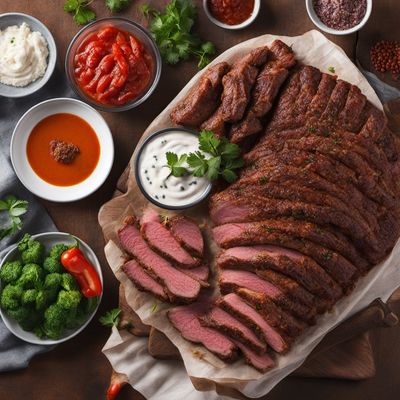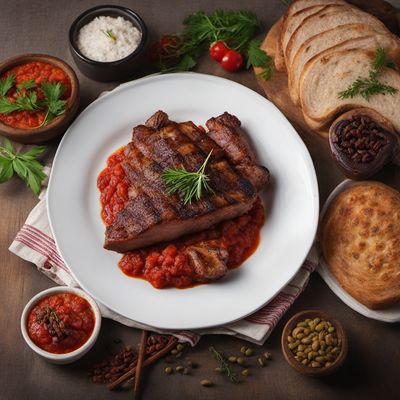
Ingredient
Cheese, kasseri
The Greek Melting Marvel: Kasseri Cheese
Kasseri cheese is a semi-hard cheese with a pale yellow color and a smooth, elastic texture. It has a rich and tangy flavor, similar to a combination of cheddar and mozzarella. When melted, it becomes gooey and stringy, making it ideal for dishes that require a melty, cheesy goodness. The cheese is typically aged for a few months, which enhances its flavor and texture.
Origins and history
Kasseri cheese originated in Greece and has a long history dating back to the Byzantine era. It is named after the region of Kassos, where it was traditionally produced. This cheese holds cultural significance in Greek cuisine and is often used in traditional dishes like saganaki, a fried cheese appetizer, and moussaka, a layered eggplant and meat casserole. Kasseri cheese is made from sheep's milk or a combination of sheep's and goat's milk, giving it a distinct flavor and aroma.
Nutritional information
Kasseri cheese is a good source of protein and calcium. It also contains essential vitamins and minerals, including vitamin A, vitamin B12, and phosphorus. However, it is high in saturated fat and sodium, so it should be consumed in moderation as part of a balanced diet.
Allergens
Contains milk.
How to select
When selecting kasseri cheese, look for a cheese that is firm to the touch and free from any mold or discoloration. The cheese should have a pleasant aroma and a slightly salty taste. Opt for a cheese that is aged for at least a few months, as this will ensure a more pronounced flavor. If possible, purchase the cheese from a reputable cheese shop or specialty store to ensure its authenticity and quality.
Storage recommendations
To maintain the freshness and quality of kasseri cheese, store it in the refrigerator in its original packaging or wrap it tightly in plastic wrap. Keep it away from strong-smelling foods to prevent flavor absorption. The cheese should be consumed within a week of opening for the best flavor and texture.
How to produce
Kasseri cheese is typically produced by heating sheep's milk or a combination of sheep's and goat's milk, adding rennet to coagulate the milk, and then pressing and aging the resulting curds. The cheese can be made at home using similar techniques, although it requires specific equipment and expertise. It is best left to professional cheesemakers or experienced home cheese enthusiasts.
Preparation tips
Kasseri cheese can be enjoyed in various ways. It can be melted and used as a topping for pizzas, sandwiches, or burgers. It can also be grated and sprinkled over pasta dishes or salads. Additionally, kasseri cheese can be served on a cheese platter alongside fruits, nuts, and crackers. When grilling or frying the cheese, make sure to use a non-stick pan or grill to prevent sticking.
Substitutions
Mozzarella, provolone, or fontina cheese can be used as substitutes for kasseri cheese. These cheeses have a similar melting ability and flavor profile, making them suitable alternatives in recipes that call for melted kasseri cheese.
Culinary uses
Kasseri cheese is commonly used in Greek cuisine, where it is a staple ingredient in dishes like spanakopita, a spinach and feta cheese pie, and tiropita, a cheese-filled pastry. It is also used in traditional Greek salads and mezze platters. Outside of Greece, kasseri cheese can be found in specialty cheese shops or Mediterranean grocery stores.
Availability
Greece, Mediterranean countries
More ingredients from this category » Browse all

Cheese, asiago
"Aged Delight: Unveiling the Richness of Asiago Cheese"

Cheese, white stilton
The Creamy Delight

Cheese, lubelski
The Creamy Delight: Exploring the Richness of Lubelski Cheese

Mozzarella cheese (specific for pizza)
The Melting Marvel: Mozzarella Cheese for Perfect Pizza

Cheese, vignerons
The Artisan's Delight: Vignerons Cheese

Cheese, passendale
Passendale: The Belgian Delight

Cheese, nokkelost
"Nokkelost: The Spiced Delight of Scandinavian Cheeses"

Cheese, tetilla
The Creamy Wonder of Tetilla Cheese

Cheese, bra
Bra Cheese: A Savory Delight

Cheese, scamorza
Smoky Delight: Unveiling the Secrets of Scamorza Cheese

Cheese, morbier
Morbier: The Creamy Delight from the Jura Mountains

Cheese, bica
The Creamy Delight: Unveiling the Secrets of Bica Cheese
Recipes using Cheese, kasseri

Leskovački Roštilj - Serbian Grilled Meat Platter
Flavors of the Balkans: A Feast of Serbian Grilled Delights

Banjalučki ćevapi with Ajvar Sauce
Savory Bosnian Beef Skewers with Roasted Red Pepper Sauce

Leskovački Voz - Serbian Grilled Meat Platter
Sizzling Serbian Delight: Leskovački Voz - A Flavorful Grilled Meat Platter

Turkish-Style Cordon Bleu
Deliciously Stuffed Turkish Cordon Bleu